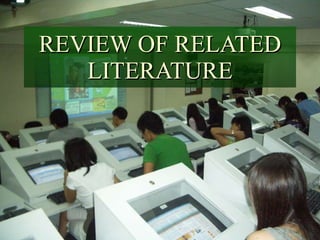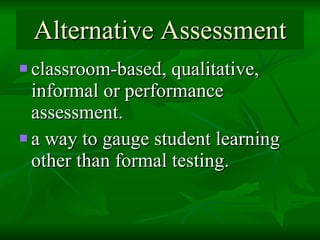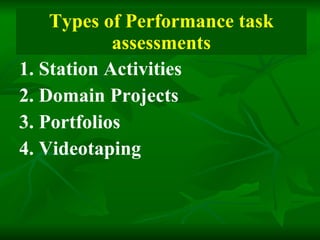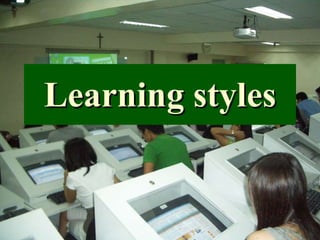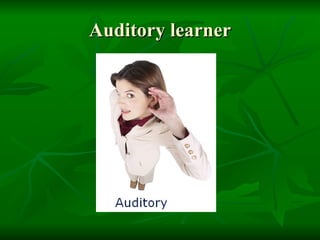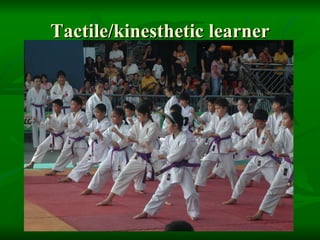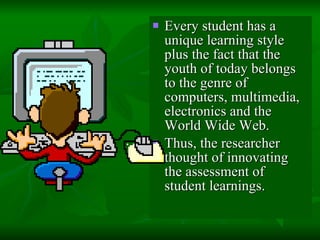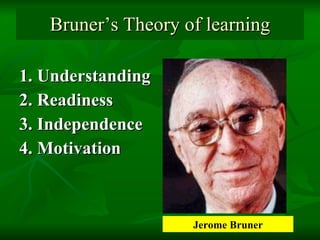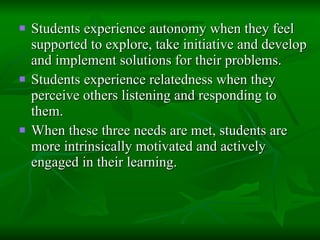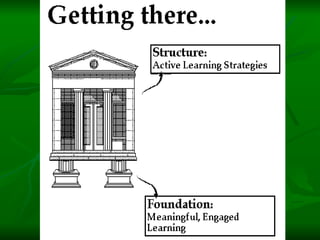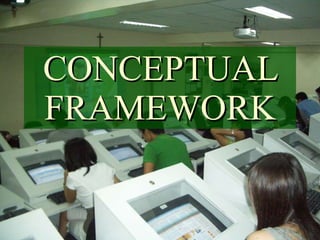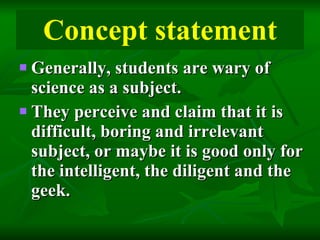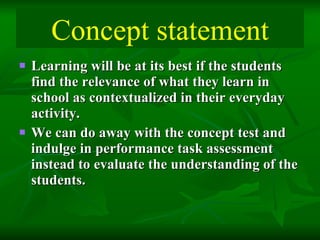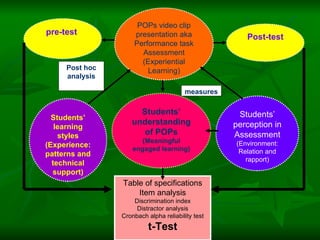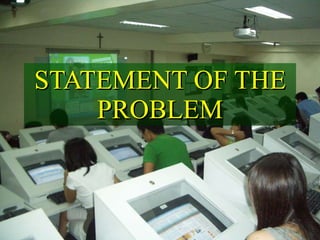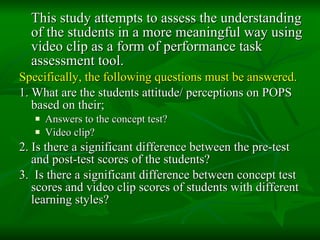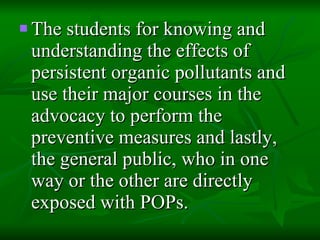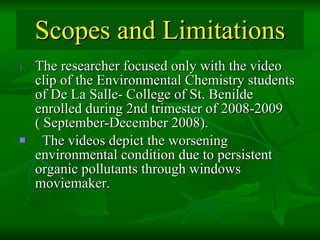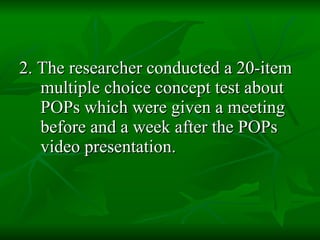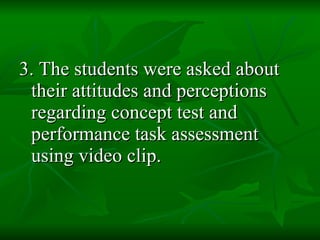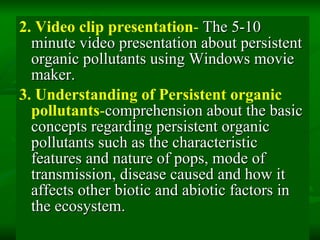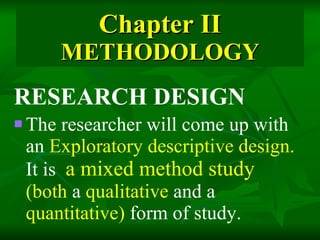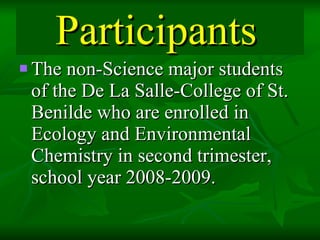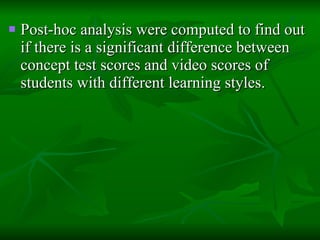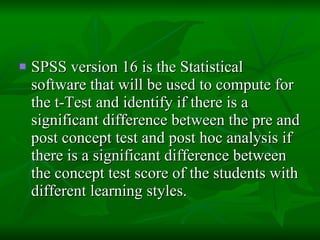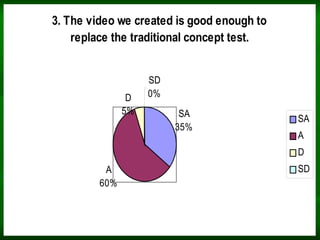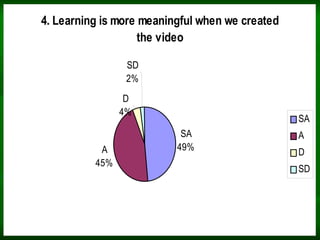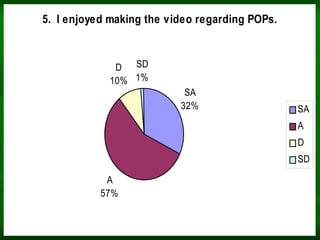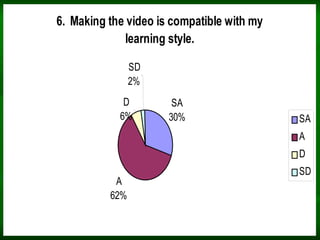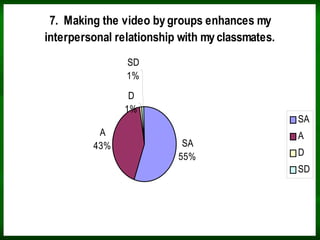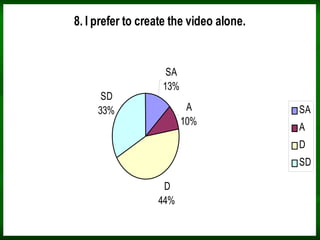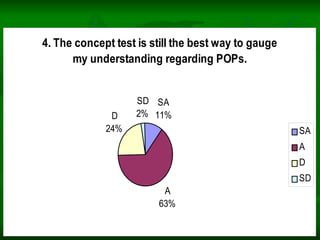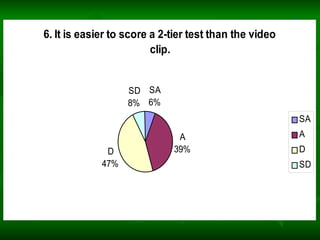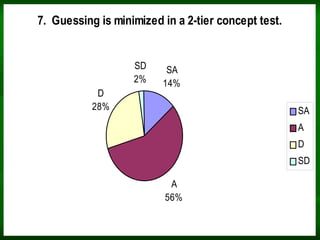Exploring the use of video clip presentation as
- 1. Exploring the Use of Video Clip Presentation as a Performance Task Assessing the StudentsŌĆÖ Understanding of Persistent Organic Pollutants Prof. Joanne Miranda De La Salle- College of St. Benilde and St. ScholasticaŌĆÖs College Manila, Philippines
- 2. Introduction
- 3. The Problem and Review of Related Literature Most, if not all non-science major students are perplexed why Science is incorporated in their curriculum. Others have fear that Science is a subject only for the intelligent, unfashionable and the geek. It is the researcherŌĆÖs dilemma how to make Science as substantial and at the same time enjoyable for the non-science major students.
- 4. What could be the methods that would arouse the interests of the youth of the new generation in learning science? How would a non-science major student find science substantial and relevant to their respective programs? These are the questions that prompted the investigation.
- 5. Many people, including many educators, think of learning as acquiring knowledge, and teaching as passing a teacher's knowledge on to the students. This has been called the banking model (students collect facts, like money in the bank, for use at some unspecified later date) or the transfer model (information is transferred from the teacher to the student). (Muir, 1997)
- 6. However, a learner-centered environment considers the teachers as facilitators and not the only source of knowledge.
- 7. They are even referred as co- learners and it accepts the idea that the teacher could even learn from the students. The level of understanding varies according to several factors. It could be due to motivation, level of interest and the studentsŌĆÖ learning style.
- 8. ╠²
- 9. ╠²
- 10. Environmental Chemistry is a 3- unit General Education subject offered among non-Science major students of DLS-CSB.
- 11. In this study, the understanding of 100 DLS-CSB students regarding Persistent organic pollutants were assessed using concept test and video clip as a form of performance task assessment. The researcher adjusted the classroom environment to the respective learning styles of the student.
- 12. Why Persistent Organic Pollutants? The researcher chose the topic Persistent organic pollutants since these pollutants are not popularly known by the lay yet affect everybody in the ecosystem. The researcherŌĆÖs idea is to make the knowledge of POPs intelligible, plausible and fruitful.
- 13. Persistent organic pollutants (POPs) are a global problem. The Philippines seeks to help reduce if not totally eliminate the use of POPs.
- 14. With the worsening problem that we encounter with persistent organic pollutants, it is very important to not only inform but also to involve the students to help minimize the problem. However, with the highly technical terminologies, it is the researcherŌĆÖs responsibility to come up with a teaching strategy that will meet the studentsŌĆÖ level of comprehension.
- 15. Objective of the Study
- 16. to use performance task assessment to evaluate the understanding of Environmental Chemistry and Ecology students featuring the detrimental effects of persistent organic pollutants and intrinsically motivate the students to participate in this advocacy campaign.
- 17. In order to fulfill this general objective, the following are the specific objectives: [1] To incorporate the students understanding about the nature of POPs, the mode of transmissions and its effects to our health and environment to their video clip presentation.
- 18. [2] To come up with the advocacy campaign in educating the lay about the detrimental effects of persistent organic pollutants by uploading the output videos at www.youtube.com
- 19. [3] To construct a 20-item two-tier test regarding POPs that will enhance the studentsŌĆÖ understanding about POPs.
- 20. [4] To compare the pre-test and post test scores after performance assessment task presentation in order to decide that video clip output is an effective alternative way of assessing the understanding of the students.
- 21. [5] To compare the video clip scores and concept test scores of the students with their respective learning styles.
- 22. REVIEW OF RELATED LITERATURE
- 23. Alternative Assessment classroom-based, qualitative, informal or performance assessment. a way to gauge student learning other than formal testing.
- 24. Performance Assessment under the umbrella of alternative assessment. requires students to demonstrate that they have mastered specific skills and competencies by performing or producing an output.
- 25. Types of Performance task assessments 1. Station Activities 2. Domain Projects 3. Portfolios 4. Videotaping
- 26. Learning styles
- 27. Visual learner
- 28. Auditory learner
- 30. Every student has a unique learning style plus the fact that the youth of today belongs to the genre of computers, multimedia, electronics and the World Wide Web. Thus, the researcher thought of innovating the assessment of student learnings.
- 32. BrunerŌĆÖs Theory of learning 1. Understanding 2. Readiness 3. Independence 4. Motivation Jerome Bruner
- 33. Self-Determination Theory (Ryan & Deci, 2004) It indicates that intrinsic motivation (doing something because it is inherently interesting or enjoyable), and thus higher quality learning, flourishes in contexts that satisfy human needs for competence, autonomy, and relatedness. Students experience competence when challenged and given prompt feedback. Ryan Deci
- 34. Students experience autonomy when they feel supported to explore, take initiative and develop and implement solutions for their problems. Students experience relatedness when they perceive others listening and responding to them. When these three needs are met, students are more intrinsically motivated and actively engaged in their learning.
- 35. Meaningful learning theory Mike Muir, 2001
- 36. ╠²
- 37. ╠²
- 39. Concept statement Generally, students are wary of science as a subject. They perceive and claim that it is difficult, boring and irrelevant subject, or maybe it is good only for the intelligent, the diligent and the geek.
- 40. It is true that there are reasons for every student behavior; that behavior manifested is a function of several factors i.e. line of interest, major course, to name a few. In this study, it is pointed that learning could be assessed and evaluated in many ways. Concept statement
- 41. Learning will be at its best if the students find the relevance of what they learn in school as contextualized in their everyday activity. We can do away with the concept test and indulge in performance task assessment instead to evaluate the understanding of the students. Concept statement
- 42. POPs video clip presentation aka Performance task Assessment (Experiential Learning) measures StudentsŌĆÖ perception in Assessment (Environment: Relation and rapport) StudentsŌĆÖ understanding of POPs (Meaningful engaged learning) StudentsŌĆÖ learning styles (Experience: patterns and technical support) Post hoc analysis Table of specifications Item analysis Discrimination index Distractor analysis Cronbach alpha reliability test t-Test pre-test Post-test
- 43. STATEMENT OF THE PROBLEM
- 44. This study attempts to assess the understanding of the students in a more meaningful way using video clip as a form of performance task assessment tool. Specifically, the following questions must be answered. 1. What are the students attitude/ perceptions on POPS based on their; Answers to the concept test? Video clip? 2. Is there a significant difference between the pre-test and post-test scores of the students? 3. Is there a significant difference between concept test scores and video clip scores of students with different learning styles?
- 45. SIGNIFICANCE OF THE STUDY The researcher seeks to help both pre-service and in service science teachers by employing a learner-centered approach by using windows movie maker to help advocate for the awareness regarding the detrimental effects of Persistent organic pollutants.
- 46. The students for knowing and understanding the effects of persistent organic pollutants and use their major courses in the advocacy to perform the preventive measures and lastly, the general public, who in one way or the other are directly exposed with POPs.
- 47. Scopes and Limitations The researcher focused only with the video clip of the Environmental Chemistry students of De La Salle- College of St. Benilde enrolled during 2nd trimester of 2008-2009 ( September-December 2008). The videos depict the worsening environmental condition due to persistent organic pollutants through windows moviemaker.
- 48. 2. The researcher conducted a 20-item multiple choice concept test about POPs which were given a meeting before and a week after the POPs video presentation.
- 49. 3. The students were asked about their attitudes and perceptions regarding concept test and performance task assessment using video clip.
- 50. DEFINITION OF TERMS 1. Performance Assessment Task - involve the creation of products and other outputs such video, play and other forms of materials in exchange for paper and pencil test.
- 51. 2. Video clip presentation - The 5-10 minute video presentation about persistent organic pollutants using Windows movie maker. 3. Understanding of Persistent organic pollutants - comprehension about the basic concepts regarding persistent organic pollutants such as the characteristic features and nature of pops, mode of transmission, disease caused and how it affects other biotic and abiotic factors in the ecosystem.
- 52. Chapter II METHODOLOGY RESEARCH DESIGN The researcher will come up with an Exploratory descriptive design. It is a mixed method study (both a qualitative and a quantitative) form of study.
- 53. Participants The non-Science major students of the De La Salle-College of St. Benilde who are enrolled in Ecology and Environmental Chemistry in second trimester, school year 2008-2009.
- 54. The Setting
- 55. Procedure (for data collection) All the students were given a 20-item two-tier pre and post-concept test that checked the understanding of the students regarding persistent organic pollutants. The researcher computed the t-Test to find out if there is a significant difference between the pre and post-test scores. The self-made rubric evaluated by five experts were used to assess the videos.
- 56. Post-hoc analysis were computed to find out if there is a significant difference between concept test scores and video scores of students with different learning styles.
- 57. Data analysis The videos will be checked according to the ff: Content (mode of transmission, characteristic feature and effects of POPs) Collaboration (Relationship and rapport) Motivation, Planning, Designing and Research Experience (Patterns and Learning styles of the students) Meaning: Usefulness in the real World
- 58. Instrumentation 1. Tools for Video-taping Windows Movie Maker. Digital camera (per group) www.youtube.com Statistical Package for Social Sciences (SPSS version16)
- 59. SPSS version 16 is the Statistical software that will be used to compute for the t-Test and identify if there is a significant difference between the pre and post concept test and post hoc analysis if there is a significant difference between the concept test score of the students with different learning styles.
- 61. ╠²
- 62. ╠²
- 63. ╠²
- 64. ╠²
- 65. ╠²
- 66. ╠²
- 67. ╠²
- 68. ╠²
- 69. ╠²
- 70. ╠²
- 71. ╠²
- 72. ╠²
- 73. ╠²
- 74. ╠²
- 75. ╠²
- 76. ╠²
- 77. Thank you!!! Live Jesus in our hearts FOREVER! That in all things... GOD may be glorified!

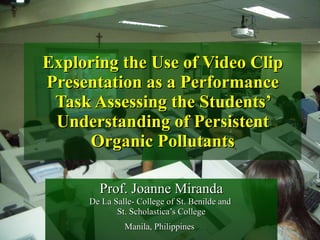


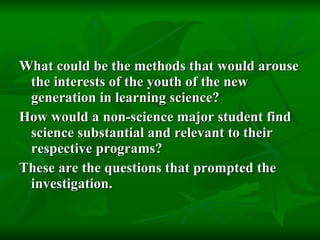
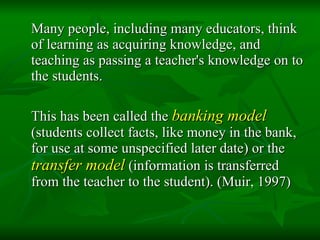

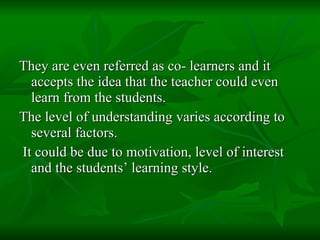
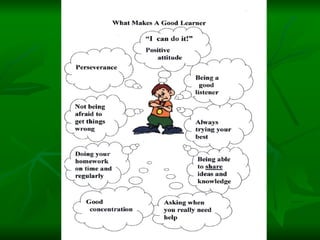

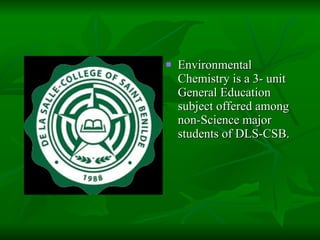
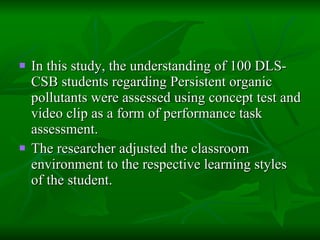
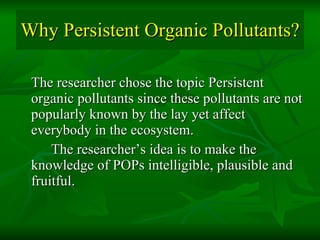
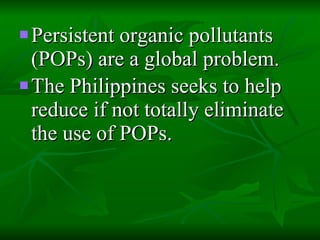
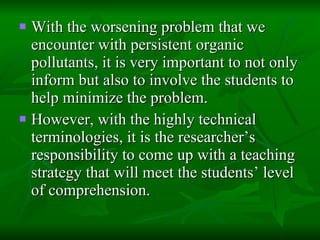

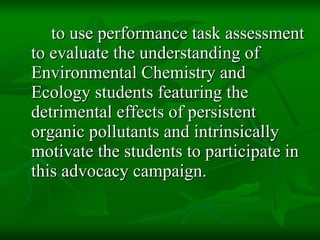
![In order to fulfill this general objective, the following are the specific objectives: [1] To incorporate the students understanding about the nature of POPs, the mode of transmissions and its effects to our health and environment to their video clip presentation.](https://image.slidesharecdn.com/exploringtheuseofvideoclippresentationas-110330223944-phpapp02/85/Exploring-the-use-of-video-clip-presentation-as-17-320.jpg)
![[2] To come up with the advocacy campaign in educating the lay about the detrimental effects of persistent organic pollutants by uploading the output videos at www.youtube.com](https://image.slidesharecdn.com/exploringtheuseofvideoclippresentationas-110330223944-phpapp02/85/Exploring-the-use-of-video-clip-presentation-as-18-320.jpg)
![[3] To construct a 20-item two-tier test regarding POPs that will enhance the studentsŌĆÖ understanding about POPs.](https://image.slidesharecdn.com/exploringtheuseofvideoclippresentationas-110330223944-phpapp02/85/Exploring-the-use-of-video-clip-presentation-as-19-320.jpg)
![[4] To compare the pre-test and post test scores after performance assessment task presentation in order to decide that video clip output is an effective alternative way of assessing the understanding of the students.](https://image.slidesharecdn.com/exploringtheuseofvideoclippresentationas-110330223944-phpapp02/85/Exploring-the-use-of-video-clip-presentation-as-20-320.jpg)
![[5] To compare the video clip scores and concept test scores of the students with their respective learning styles.](https://image.slidesharecdn.com/exploringtheuseofvideoclippresentationas-110330223944-phpapp02/85/Exploring-the-use-of-video-clip-presentation-as-21-320.jpg)
